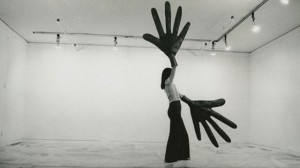Help Desk is where I answer your queries about making, exhibiting, finding, marketing, buying, selling — or any other activity related to contemporary art. Submit your questions anonymously here: http://bit.ly/132VchD. All submissions become the property of Daily Serving. Help Desk is co-sponsored by Daily Serving.
I am not trained as a visual artist — I hold my graduate degree in dance choreography and before grad school I worked primarily in live theatrical concert dance. However, in grad school my focus shifted and I started developing work in performance that should live in a gallery space. Now that I am out of school, I have a great new project in the works, but I have no idea how to make it happen! To get shows produced in dance is a complicated and nuanced procedure, but I at least understand the steps. I am totally at a loss on how to enter into the art world and negotiate a show. I’m not interested in getting the work into the “market” per se, so a for-profit gallery is probably not my best bet. Can you let me know some of the unspoken rules for approaching art spaces/museums with performance work? I want to make sure that I don’t seem tone deaf to the conventions of the form. If it were a concert show in a traditional theater, here’s how I’d approach it: I would narrow down a couple of producers, send them a press packet, invite them to rehearsals and in-progress showings to develop a relationship, and then finally just ask for a show. For people I already knew, I might do an exploratory email pitch: “I have this cool idea in development, would you be interested in talking?”
Good question! You’re obviously motivated and organized, and also sensitive enough to understand that changing your approach and observing the rules of contemporary art spaces will serve your goals better than charging ahead with the protocols for pitching to traditional theaters. I sent your question to Katya Min, Curator of Public Programs at the Yerba Buena Center for the Arts in San Francisco, and she had a lot of good advice for you. To begin with, she says, “Whether or not you’re an established or an emerging artist, navigating the turbulent waters of the art world can be a taxing and largely intimidating process. Before elaborating on the areas that I would be conscious of, coming from a curator’s perspective, I will offer this relatively common sense advice: there are really no right or wrong approaches. Each curator is different, thus each will have a different method of seeking artists or projects. The approach I would recommend is actually not dissimilar from the approach you described for traditional theater, but with that said, I hope these tips will help guide you on your way.”
Katya’s wise counsel continues:
“Research: Take the time to do your research by reading about potential venues, arts & culture blogs, and relevant publications. Do they have applications for an open call for artists? What type of artwork do they normally exhibit? Familiarizing yourself with the content and mission of a space will not only help you determine if your work would be a good fit, but also demonstrates your understanding of the space’s aesthetic and the kinds of work they (re)present. Often galleries and museums host special programs that involve temporary performative installations for exhibition openings, which is a great avenue for artists who are just starting out. Artists whose work is based in movement and/or conceptual performance often present as part of temporary live act projects at these openings.
“Network: Create/find support networks amongst fellow artists. Artists can support each other by sharing information, artist open calls, and spreading good leads, etc. A good way to meet and engage with fellow artists is attending as many museums, gallery shows, openings, and events as you can; actively joining the art community is a valuable way to gain insight and friends.



